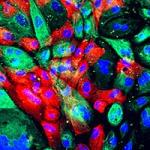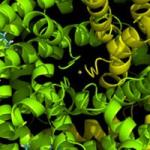
John Allan Hanover, Ph.D.
Senior Investigator
Cell Biochemistry Section, Laboratory of Cell & Molecular Biology
NIDDK
Research Topics
Our laboratory focuses on (1) the molecular features of a novel, glycan-dependent, signal transduction cascade and (2) the mechanism of nuclear transport. The nuclear transport of transcription factors, nuclear kinases, steroid hormone receptors, and replication factors often serves a critical regulatory function. We are examining the mechanisms of nuclear import, export, and subnuclear targeting. We identified a novel nuclear transport pathway involving calmodulin. This pathway has been shown to play a role in mammalian sex determination and stem cell differentiation. We are identifying additional components of this pathway using yeast genetics and chemical biology approaches.
The nuclear pore complex (NPC) mediates the transport of mRNA and proteins across the nuclear envelope. Many components of the nuclear pore are modified by a novel modification: O-linked N-acetylglucosamine (O-linked GlcNAc). The modification also occurs on transcription factors and certain oncogenes and tumor suppressors. Current evidence suggests that the O-linked GlcNAc transferase (OGT) mediates a novel glycan-dependent signal transduction pathway. We have molecularly cloned and characterized the human OGT responsible for glycosylating nuclear pore proteins. This enzyme is expressed as differentially targeted isoforms in man and is localized to both the nucleus and the mitochondria. When expressed in E. coli, the human OGT is catalytically active. We recently solved the X-ray structure of the substrate recognition domain of OGT and we are beginning to understand how it recognizes its many intracellular targets. Although the enzyme is found in a number of target tissues, it is most highly expressed in human pancreatic beta cells, consistent with a role in glucose-sensing. Based on its substrate specificity and molecular features, we have proposed that OGT is the terminal step in a glucose-responsive pathway that becomes dysregulated in diabetes mellitus (NIDDM).
Applying our Research
Our studies may provide insight into how nutrition may impact the health of both mother and offspring.
Need for Further Study
The enzyme catalyzing O-GlcNAc removal, O-GlcNAcase, has also been identified, expressed, and shown to exist as differentially targeted isoforms in man. We are also using the genetically amenable C. elegans model to examine the physiological impact of the enzymes of O-GlcNAc cycling. Using reverse genetics, knockout, and other transgenic models, we are currently exploring the role of these essential genes in signal transduction and pathogenesis of diabetes mellitus. Our studies further suggest that O-GlcNAc cycling plays a key role in the regulation of chromatin structure and may be a key player in epigenetic reprogramming in response to nutrition and other environmental influences.
Biography
- Ph.D., Johns Hopkins University School of Medicine, 1981
- B.S., University of Tulsa, 1976
Selected Publications
- Mukherjee MM, Biesbrock D, Abramowitz LK, Pavan M, Kumar B, Walter PJ, Azadi P, Jacobson KA, Hanover JA. Selective bioorthogonal probe for N-glycan hybrid structures. Nat Chem Biol. 2025;21(5):681-692.
- Mathew MP, Abramowitz LK, Donaldson JG, Hanover JA. Nutrient-responsive O-GlcNAcylation dynamically modulates the secretion of glycan-binding protein galectin 3. J Biol Chem. 2022;298(3):101743.
- Na HJ, Abramowitz LK, Hanover JA. Cytosolic O-GlcNAcylation and PNG1 maintain Drosophila gut homeostasis by regulating proliferation and apoptosis. PLoS Genet. 2022;18(3):e1010128.
- Konzman D, Fukushige T, Dagnachew M, Krause M, Hanover JA. O-GlcNAc transferase plays a non-catalytic role in C. elegans male fertility. PLoS Genet. 2022;18(11):e1010273.
- Na HJ, Akan I, Abramowitz LK, Hanover JA. Nutrient-Driven O-GlcNAcylation Controls DNA Damage Repair Signaling and Stem/Progenitor Cell Homeostasis. Cell Rep. 2020;31(6):107632.
Related Scientific Focus Areas


Molecular Biology and Biochemistry
View additional Principal Investigators in Molecular Biology and Biochemistry



This page was last updated on Tuesday, August 12, 2025